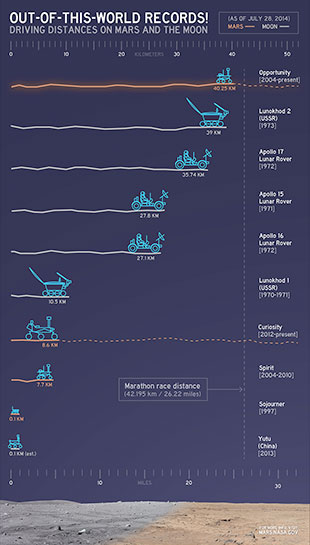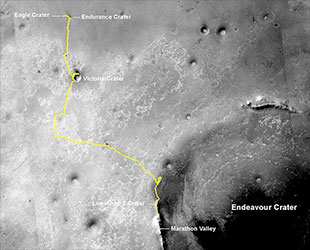July 28, 2014 — A NASA rover has set the new distance record for off-world driving, covering 25 miles during its 10 years on Mars.
Opportunity, one of a pair of U.S. Mars Exploration Rovers (MER) that landed on the Red Planet in 2004, rolled past the prior distance record set in 1973 by the former Soviet Union's Lunokhod 2 rover on the Earth's moon.
"Opportunity has driven farther than any other vehicle on another world," project manager John Callas with NASA's Jet Propulsion Laboratory (JPL) in Pasadena, Calif., said in a statement released on Monday (July 28). "This is so remarkable considering Opportunity was intended to drive about one kilometer and was never designed for distance."
"What is really important is not how many miles the rover has racked up," he continued, "but how much exploration and discovery we have accomplished over that distance."
A short drive of 157 feet (48 meters) on Sunday (July 27) advanced Opportunity's odometer to 25.01 miles, or 40.25 kilometers, while driving southward along the western rim of Mars' Endeavour Crater.

This chart (click image to enlarge) illustrates distances driven by various wheeled vehicles on the surface of the moon and Mars. |
As Opportunity neared the mileage record earlier this year, the rover team chose the name "Lunokhod 2" for a crater about 20 feet (6 meters) in diameter on the outer slope of Endeavour's rim.
Opportunity had driven more than 20 miles (32 kilometers) before arriving at Endeavour Crater in 2011, where it has examined outcrops on the crater's rim containing clay and sulfate-bearing minerals. The sites are yielding evidence of ancient environments with less acidic water than those examined at where Opportunity landed.
If the rover can continue to operate, covering the distance of a marathon – 26.2 miles (about 42.2 kilometers) – it will approach the next major investigation site, which mission scientists have dubbed "Marathon Valley." Observations from spacecraft in orbit around Mars suggest that several clay minerals are exposed close together at this next site, surrounded by steep slopes where the relationship among different layers may be evident.
The Russian Lunokhod 2 rover, a successor to the first Lunokhod mission in 1970, landed on the moon in January 1973, where it drove about 24.2 miles (39 km) in less than five months, according to recent calculations made using images from NASA's Lunar Reconnaissance Orbiter (LRO) that have revealed Lunokhod 2's tracks.
Irina Karachevtseva with the Moscow State University of Geodesy and Cartography's Extraterrestrial Laboratory in Russia, Brad Jolliff of Washington University in St. Louis, Tim Parker of JPL, and others, collaborated to verify that the map-based methods for computing the distances were comparable for both Lunokhod 2 and Opportunity.

Map showing Opportunity's route from landing to its location after the record was set July 27. (NASA/JPL-Caltech/MSSS/NMMNHS) |
"The Lunokhod missions still stand as two signature accomplishments of what I think of as the first golden age of planetary exploration, the 1960s and '70s," said Steve Squyres of Cornell University in New York, and principal investigator for the two Mars Exploration Rovers. "We're in a second golden age now, and what we have tried to do on Mars with Spirit and Opportunity has been very much inspired by the accomplishments of the Lunokhod team on the moon so many years ago. It has been a real honor to follow in their historical wheel tracks."
Opportunity is one of two functioning rovers on the Martian surface today. The other, NASA's Curiosity, has traveled just over 5.3 miles (8.6 km) since landing in August 2012. Spirit, Opportunity's twin, logged 4.8 miles (7.7 km) before becoming stuck in soft soil in 2009, more than five years after after arriving on the Red Planet.
After Opportunity and Lunokhod 2, the third place record for off-Earth mileage is currently held by the lunar roving vehicle driven during Apollo 17, the last (to date) manned mission to the moon. NASA astronauts Gene Cernan and Harrison Schmitt drove the "moon buggy" 22.2 miles (35.7 km) over the course of three days in December 1972.
